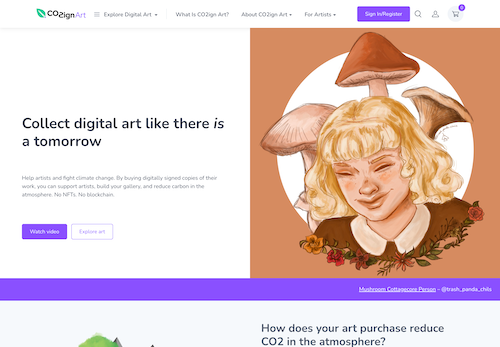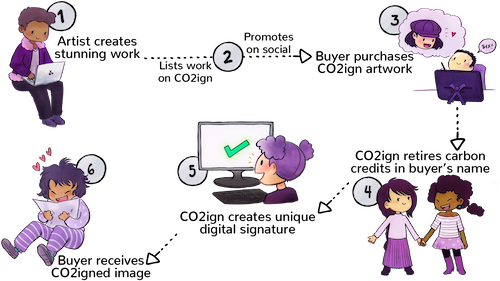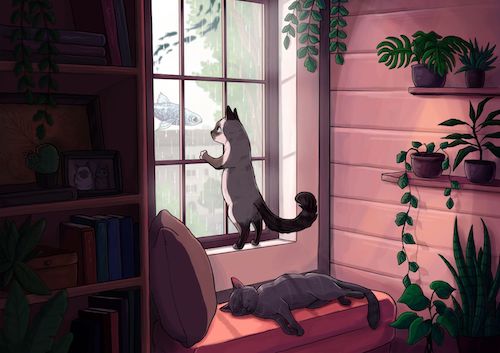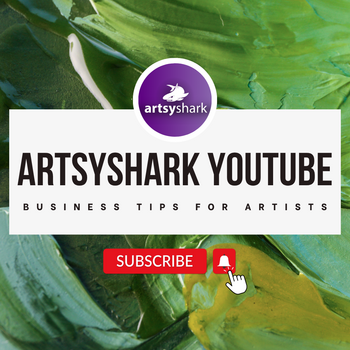An expert on the digital art market discusses options, challenges and the future of making sales.

Carly Rector, founder and chief architect of CO2ign Art
Carly Rector, founder of CO2ign Art, software engineer, and long-time patron of digital art, spoke with us about the state of the market for artists working in digital mediums, and the evolution of this sales channel.
AS: How would you define digital art?
CR: Digital art is any art that’s created with a computer rather than with traditional physical media. That covers a very broad range, from digital drawing and painting where you’re replicating ink and paint using a tablet and stylus, to digital-only mediums like 3D modeling and animation, to art generated entirely by an algorithm or AI.
There’s been a lot of attention around NFTs and AI art lately. But I think it’s important to remember that digital art has existed for almost as long as computers. Most of the time there’s a human working in largely the same way artists do with traditional pieces. They’re still creating the art; they just have the advantage of layers, filters, and an undo button. There’s not less creativity there, it’s simply a different medium.

CO2ign Art homepage, Artwork courtesy of trash_panda_chils
AS: What channels are there to sell digital art?
CR: That depends on what you mean by “sell digital art.” Digital art is fundamentally different from physical art. There isn’t a single unique piece created that the artist can transfer to someone else. When you give someone a digital file, you also still have the file. Both of you can continue to share it with as many people as you want to. On a technical level, on the internet there’s no distinction between seeing an image and having the image. So, you have to redefine what exactly it is you’re selling. There are a number of options.
You can sell access to art – buyers pay to see the art, or to access a full or higher-quality version of it. People might buy a comic or a high-res download. Etsy and Gumroad are common ways for independent artists to do this.
You can sell physical copies of art – either printing it yourself or via print-on-demand marketplaces. This can include putting your art on merchandise like phone cases and t-shirts. Artstation sells prints, for example, and Redbubble is popular on the merch side.
You can sell the creation of new art – commissioned work based on a client’s specifications. This can be done via freelance marketplaces like Fiverr. Commissions are also frequently offered on social media where artists already have followings.
You can sell NFTs of art, which are blockchain tokens that function as a “deed” to the art. NFTs represent ownership in a decentralized way rather than relying on any one authority. OpenSea is the largest NFT marketplace.
Finally, there’s a new option on my platform, CO2ign Art. You can sell digital copies of art that help fight climate change. Each copy has a verifiable digital signature in the metadata of the file. The image can still be copied, but the signature is a “proof-of-purchase” identifying a single buyer and a specific CO2 reduction project funded by their purchase.
In all of these options, the purchase may or may not also confer legal rights to use the art. That depends on the terms of the sale.
AS: What about other options for making money from digital art?
CR: You can also get income from patronage or donation. Artists often use platforms like Patreon or Ko-fi where people sign up for a monthly subscription to support your art. This sort of system calls back to the old “patron of the arts” where wealthy people would fund artists to do their work without necessarily getting something out of it directly.
Practically, digital artists often offer one or more of the above in their Patreon tiers, and also “bonuses” like interaction with the artist, a community they moderate, “behind the scenes” content, and so on.

How it works – the CO2ign Art process for listing and selling art
AS: What are some of the barriers digital artists face when selling their work?
CR: Selling access to art is difficult because it’s so easy to access content online. It’s an unfortunate conflict. The big advantage of the internet and of digital art is that it’s easy to reach a large audience. In general, artists enjoy when a lot of people see and appreciate their work. Artists also (reasonably) want their work to be properly credited and get paid for it. However, if your art is behind a paywall, you have to convince people it’s worth paying to see it. That’s going to draw a much smaller audience, and you have to continually police the web to make sure no one makes it available for free. It’s an arms race of watermarking, scripts to try to stop right click-saving, and so on. It’s always going to be an uphill battle trying to force scarcity onto a medium that fundamentally doesn’t work that way.
Some of the other options allow you to share work freely, but have issues that can make it hard to make real money. Prints and physical merch are popular, but they sell for low prices since they feel like interchangeable commodities. They have even lower margins for artists after production and shipping costs. Commissions take a lot of time and coordination with the client and are difficult to do at a high volume. Patreon requires highly committed fans and often a lot of “bonus” work.
The ideal vision of both NFTs and my platform, CO2ign Art, is to sell your art in a truly digital way without having to restrict access to it. That requires focus on a different kind of value. This isn’t unheard of. For example, in the physical world signed prints are valued more highly than mass-produced ones because people value the limited quantity and the personal touch of the artist. In the case of NFTs, the value is the unique token representing your ownership on the blockchain and the collective consensus behind its authenticity. In the case of CO2ign Art, the value is supporting the artist and fighting climate change. This is verifiable via digital signatures.
AS: At this time, can artists listing NFTs expect to sell their work? Who is selling?
CR: Notably, art NFTs have been the category of NFTs most resilient in the face of the current crypto crash, which shows they have some durable value. Some artists have been very successful selling NFTs. There are people who deeply believe in them as the way of the future.
However, I don’t think artists should expect to just go mint an NFT and see it sell. Statistically, most NFTs do not sell, and many more of them only sell once. The NFT space is very driven by community hype and the expectation of future returns. The NFT projects that sell most are ones where the artist already has a devoted audience, or where they’re able to form a community convinced that they’re the next big thing. Collections with a few thousand variants on the same basic theme also tend to sell more than unique pieces, because it’s much easier to build a community around those, and therefore to have a secondary market.
Personally, I think NFTs will settle into being most used where they’re most useful, which is for the kind of art where authenticity and provenance is very important. This would be high-profile pieces, or collectables that are traded frequently. Most art doesn’t fall into that category even in the traditional art world, and it’s rare for a piece to be sold more than once. That doesn’t mean other art doesn’t have value; clearly people buy art even when it isn’t an authentic Picasso or a trading card. It just isn’t the same kind of value.

“Connection” by Rita Vigovszky (available on CO2ign Art)
AS: With theft and infringement a common problem, things are rough for digital artists. What’s the outlook for the future?
CR: We’re really at a turning point for digital art in a lot of ways. Art is moving more and more online. People who grew up making art on their iPad are now adults creating amazing work. There’s unprecedented access to references and tutorials online, and there are new tools coming out every day that allow artists to do things that would have been arduous or impossible before. A single artist on a modest budget can now make impressive animations or rig a 3D model to mirror their facial expressions. People can livestream painting and have thousands of people watch them. There are entirely new mediums coming into existence.
At the same time, there are definitely struggles. The ease of accessing art online has led to a lot of theft and copyright infringement, and a lot of controversy over what counts as theft and copyright infringement. The people making this amazing art are often not making any money from it and having their creative work stolen.
However, there’s also a growing amount of attention on these things and therefore many people trying to address them. There are new ways to value the work artists do, like Patreon, NFTs, or CO2ign Art. There are ways to identify infringement or track who created something, like DeviantArt Protect or the Content Authenticity Initiative.
I’m sure these efforts will continue. Ultimately, digital artists are artists. There are enough people who believe in the value of the creative work artists do that opportunities will continue to improve for digital artists going forward.
Follow CO2ign Art on Twitter and Instagram.




[…] investors must identify promising projects, and collectors must navigate an ever-expanding digital art market. The importance of education and awareness cannot be overstated in a field where change is the only […]